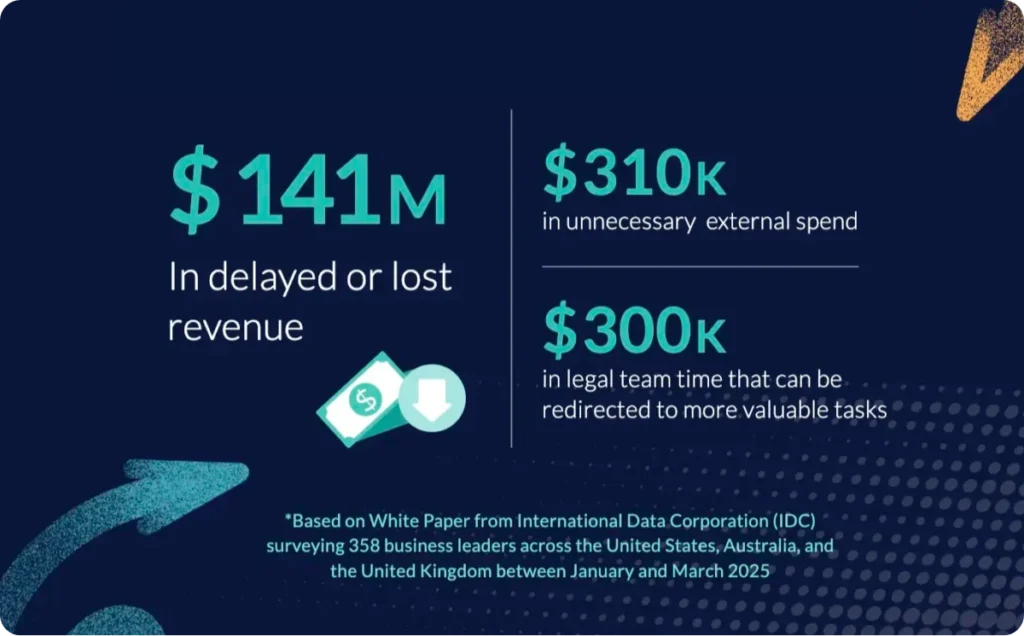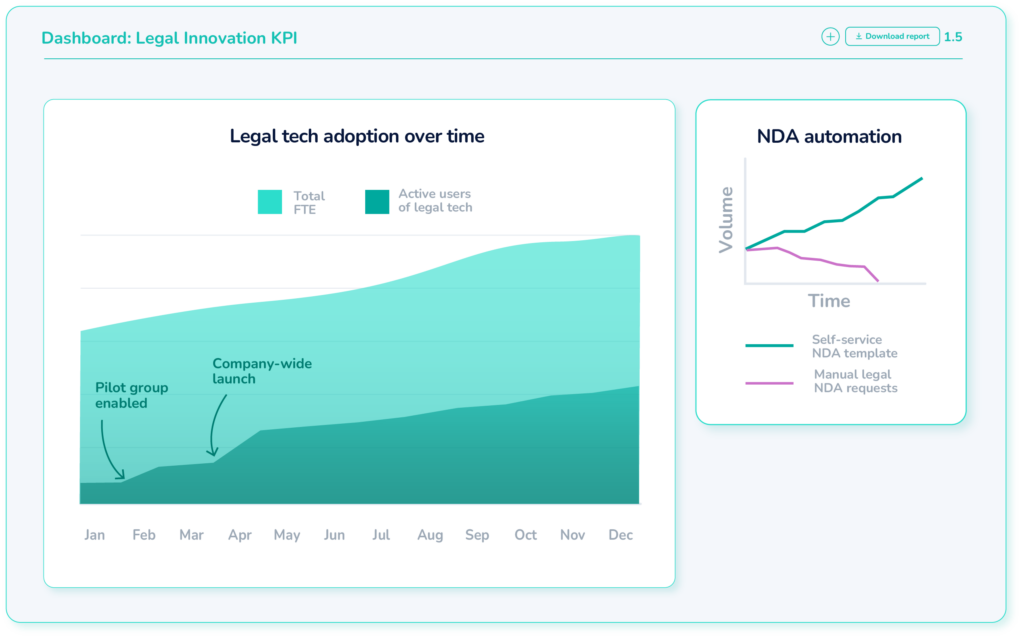How to measure the return on investment (ROI) of legal tech and communicate it to the business

In-house legal teams are under growing pressure to demonstrate their value to the business. Investments in the right legal technology tools can help in-house teams increase operating excellence and show value – but like any investment, it needs to show an obvious return.
Revisit: The in-house legal tech stack and what tools it should contain
Gartner research amid workload and budget pressures, and those that have tech in place may be asked to prove its ROI when budgets are scrutinized. That’s why knowing how to measure and communicate about ROI is so important. Done well, it not only validates existing investments but also strengthens your business case when you’re seeking budget for new tools.
This guide explains how to measure return on investment (ROI) across time, money, and risk – and how to translate that value into business language your stakeholders will support.
What does return on investment (ROI) mean for legal tech?
When most people hear (ROI) they think about dollars in and dollars out. A common way to calculate financial ROI is:

But for legal teams, return on investment isn’t always a simple financial equation, it’s about the value returned to the business – and not all of that is easily quantifiable.
Legal tech ROI often shows up in ways that matter deeply to both legal and the wider organization:
- Time saved – reducing manual admin so lawyers focus on higher-value work
- Cost avoided – cutting outside counsel spend or preventing wasted resources
- Risk reduced – ensuring deadlines aren’t missed and compliance is maintained
- Speed to business outcomes – helping sales close deals faster or HR onboard employees efficiently has clear commercial impact
- Visibility and data improvements – giving leadership clearer insights into legal workload, contracts, and spend – and the data needed to budget and plan well.
- Stronger business partnerships – operational excellence builds trust with stakeholders, reduces friction, and helps legal to be a strategic enabler and competitive advantage
While these benefits may not all translate directly into dollars, together they form a powerful ROI story that connects legal activity and legal investments to business impact.
A framework for measuring legal tech ROI
ROI isn’t only something you calculate after technology is in place. A clear framework helps you make the case for investment upfront as well as demonstrate results later.
1. Define your baseline (or pain points)
Start by describing what life looks like today. If you have data, capture it:
- Average contract turnaround time
- Volume of legal requests received
- Outside counsel spend
- Time spent on routine admin
But don’t worry if you don’t have precise measurements yet. Many teams start with a shared sense of frustration – deals delayed, requests lost in email, too much money going to outside counsel. This is still a baseline.
Tip: Your stakeholders will feel pain points as well, and they’ll be worth referring to when you measure and communicate about ROI. Use this legal technology alignment survey to specifically capture stakeholder priorities, pain points, and areas where you can deliver the most value.
To make the value of potential or current investment more tangible, combine your anecdotal evidence with industry benchmarks.
For example, a recent IDC white paper, shows that 67 percent of business leaders say ineffective legal processes negatively impact outcomes, and IDC estimates legal friction costs enterprises $141M in lost revenue, $310K in wasted legal spend, and $300K in lawyer time every year. Even scaled down, these numbers illustrate the hidden cost of inaction.

2. Identify measurable outcomes (future or actual)
Next, highlight what improvements technology could unlock – or has already delivered if you’re measuring post-implementation. Common examples include:
- Contract cycle times – for example, LawVu customers report 45 percent faster and more efficient cycle times
- Hours saved – the value of legal team time saved can be easily quantified, and of course there is value in freeing up legal capacity for higher-value work
- Outside counsel spend – cut reliance on external firms for routine tasks; industry research indicates in-house teams can save between one and 12 percent of outside counsel spend by implementing technology
- Business self-service – increase percentage of requests resolved without legal involvement, which can be translated into quantifiable time saved as well as a way to reduce risk and speed up time to commercial value
- Matter management improvements – more matters resolved on time, with better visibility into risk and less lawyer time spent on admin, freeing capacity for strategic work
Even if you’re still in the planning stage, frame these as directional goals. Stakeholders care about the potential trajectory, not just the past.
+
%
+
%
3. Assign value where possible
Finally, translate outcomes into business terms. This is where ROI becomes persuasive. Options include:
- Time to cost: Hours saved × average lawyer cost = efficiency gain
- Revenue acceleration: Faster deal close = earlier revenue recognition
- Risk avoidance: Quantify the financial or reputational impact of missed deadlines or compliance gaps
- External validation: When internal data isn’t available, use benchmarks like the IDC report to fill the gaps
You don’t need perfect precision – directional estimates, framed in business language, are often enough to win budget discussions.
4. Include qualitative ROI
Not everything that matters can be captured in a spreadsheet or quantified with hard numbers. Some of the most meaningful returns on legal tech are qualitative – but they’re no less important when building a business case.
Examples include:
- Improved stakeholder satisfaction – if you have tech in place, you can capture feedback through surveys or even a simple net promoter score (NPS) for legal services
- Higher legal team morale – less frustration with manual work and more time for impactful projects
- Business enablement and trust – with better processes, legal shifts from being a perceived bottleneck to a partner that accelerates deals, hiring, and strategic initiatives
- Data-driven decision making – shifting legal from anecdotal advice to evidence-based insights, giving the business greater confidence and clarity.
The best ROI stories combine quantitative evidence (hours saved, costs reduced) with qualitative narratives (business alignment, morale, reputation). Together, they paint a holistic picture of the value legal tech delivers.
How to make qualitative ROI actionable
One simple way to approach this is to run a short stakeholder alignment survey. Ask your business partners where they see legal helping (or slowing) progress, what they need most, and how they rate legal’s support today versus after new tech is in place.
LawVu’s legal tech alignment survey is a free tool you can use to gather this feedback. The results give you a specific way to track improvements in satisfaction and alignment over time, and to show executives that legal is becoming a stronger business partner.
How to communicate ROI to the business
Measuring or estimating ROI is only half the battle – the real impact comes from how you communicate it. To win support and sustain investment, your message needs to resonate with different audiences across the business.
Tailor your story
- CFOs want numbers: Cost savings, revenue acceleration, and risk avoidance translated into financial terms.
- COOs look for efficiency: Faster processes, smoother operations, and less friction across departments.
- CEOs and business leaders want impact: How legal is enabling growth, improving relationships, and building confidence.
This free business case template has everything you need to present the information your key stakeholders will respond to best, in a customizable slide deck:
Keep it simple and outcome-focused
Avoid drowning stakeholders in legal jargon or system detail. Instead, share the outcomes: time saved, cost avoided, risk reduced, and business value delivered.
Show the difference
Before-and-after stories are powerful. For example: “Contract approvals used to take 10 days. With new workflows, they take three, saving sales two weeks per deal.” Real stories stick.
Use visuals and reporting tools
Dashboards, charts, and simple one-pagers bring ROI to life in ways that raw numbers can’t. Visuals also make it easier for executives to share your message with others.

Build ROI into ongoing conversations
Don’t save ROI reporting for renewal season. Schedule regular updates with leadership to reinforce the value of legal tech and keep legal positioned as a proactive partner in the business.
Tools and tips for ongoing measurement
ROI isn’t just something you measure once to get budget approval. To keep legal positioned as a strategic partner, it’s worth tracking and reporting on ROI over time. Here are some ways to make that sustainable:
- Build ROI tracking into your implementation plan Decide upfront which metrics matter most (eg contract cycle time, outside counsel spend, stakeholder satisfaction) and how you’ll capture them.
- Leverage platform dashboards Many legal tech platforms, including LawVu, have built-in reporting that makes it easy to track time savings, matter status, and other ROI metrics.
- Partner with finance or operations Bring in colleagues from finance or ops to validate your calculations and ensure the numbers resonate with the business.
- Track progress regularly Quarterly or biannual updates are enough to show trends, keep leadership engaged, and help you refine your ROI story over time.
Ready to put numbers around your own business case?
Measuring ROI may feel daunting at first, but it doesn’t have to be complicated. By combining a clear framework, credible data, and stakeholder-focused storytelling, legal leaders can demonstrate the tangible and intangible value of technology – and use that story to secure future investment.
The result is more than just cost savings. It’s a legal function that enables the business to move faster, reduces risk, and earns a stronger seat at the table.
Ready to put numbers around your own business case? Try our ROI calculator to get started.




